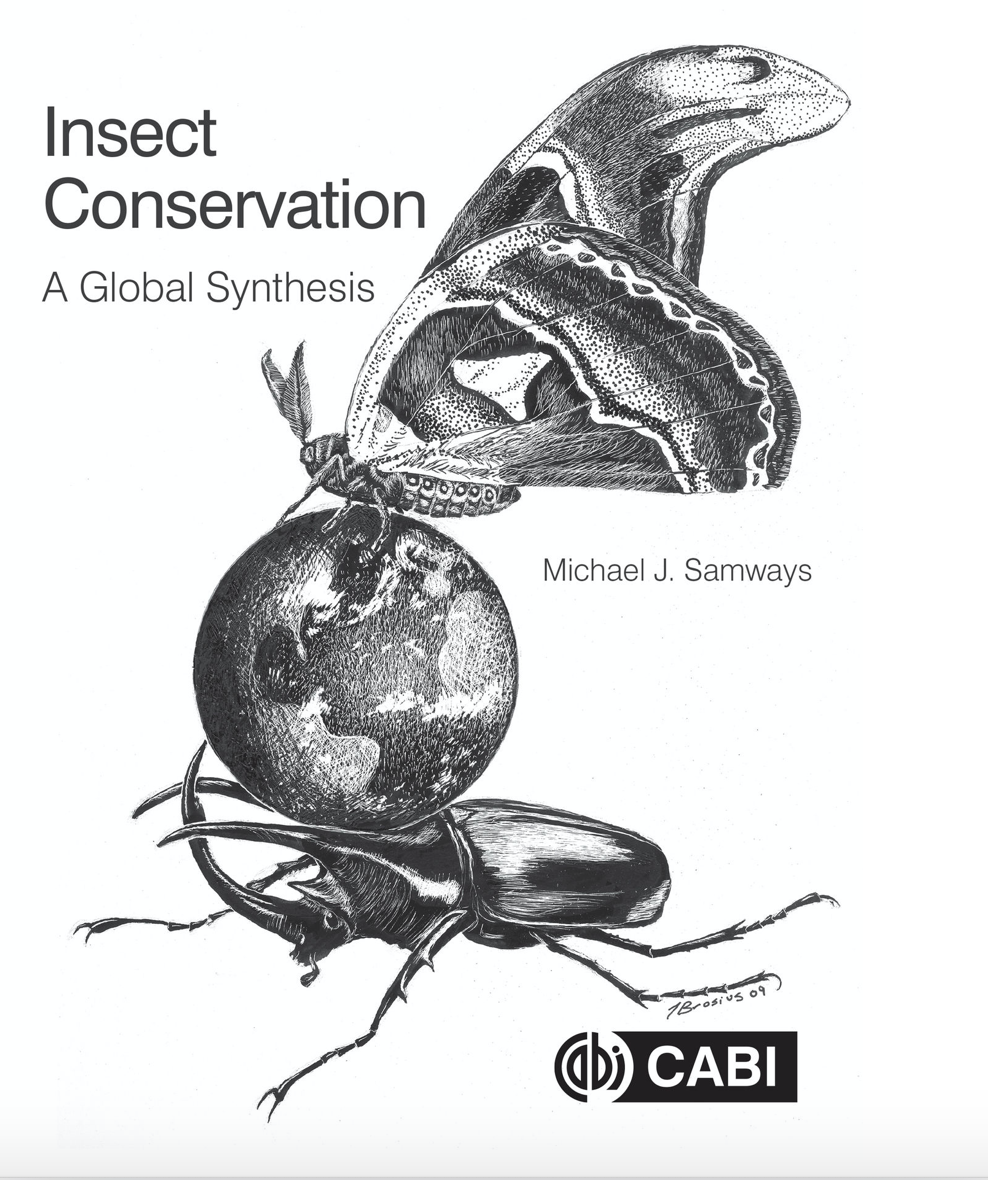Biodiversity Conservation Ecology
Michael J. Samways
CABI
2020
ISBN: 9781789241686
Reviewed by Alan Stewart
Insect conservation, once a Cinderella subject in traditional conservation circles, has come of age. No entomologist will need reminding that many of ‘the little things that run the world’, in E.O. Wilson’s memorable phrase, are every bit as threatened with population decline and extinction as some of the more charismatic big mammals that engender so much public support. Michael Samways has been the torchbearer for this rapidly expanding field through his research, books, talks and popular writings. He had already written several books on various aspects of insect conservation, but this magnum opus is certainly the largest (540 pages) and most comprehensive.
The book contains thirteen chapters that can be divided into three broad themes. The first of these sets out the main foundations of insect conservation and the three operational scales which are then dealt with in separate chapters: whole landscapes (coarse filter), landscape features including habitat patch size, connectivity and heterogeneity (meso-filter) and species focus (fine filter). This is followed by a chapter that considers the general approaches to insect conservation, including setting priorities, red listing, defining conservation units and strategic planning. The next section contains chapters that are each devoted to the insect conservation issues and challenges of four broad habitat categories: agricultural; forest, grassland and cave; freshwater; and urban. This section then finishes with a consideration of habitat restoration for insects and the ecosystem services they provide. The final section considers some methodological concepts such as global through to local assessments of insect species and diversity, species inventories and mapping, as well as the concepts of surrogacy and bioindicators. The final chapter considers what the future holds for insects in the new Anthropocene, with its twin challenges of global biodiversity declines and climate change. The last sentence of the book asserts that, whilst we have the conservation tools to rescue the situation, based on knowledge gained from research, what is needed now is the will and determination for action.
The beauty of the book’s format is that it provides the reader with access to the subject matter at three different but complementary levels. Firstly, the text is rich in detail and densely supported by references to the primary literature, providing an in-depth analysis of each topic. Secondly, there are detailed line drawings throughout to illustrate the main points, fully supported with extensive explanatory legends; a good appreciation of the main points of each chapter could be gleaned from these graphics alone. Thirdly, each chapter finishes with a long list of key bullet points, included as a revision guide for undergraduate students but equally suitable and useful for time-pressed lecturers and researchers.
The book has appeared at a highly opportune time, when scientists, conservationists and the general public have been alerted to the possibility of widespread declines in insects and the ecosystem services that they provide. Three of the initial studies about global insect declines that generated so much recent attention in the media, and indeed controversy amongst insect ecologists, are referred to in the book: the ‘Krefeld study’ (Hallmann et al. (2017) PLoS ONE 12, e0185809) showing a 75% decline in biomass of insects caught in a network of Malaise traps in Germany over 27 years; one of the first global reviews of insect declines by Sanchez-Bayo and Wyckhuys (2019, Biological Conservation 232, 8–27); and the apparently climate-driven collapse of insect abundance in a tropical rainforest (Lister and Garcia (2018) PNAS 115, e10397). However, the book must have gone to press just as the subsequent cascade of papers and reviews on long-term changes in insect populations started to appear. Thus, important reviews and meta-analyses that have appeared since are missed, such as by Wagner (2020, Annual Review of Entomology 65, 457–480), Seibold et al. (2019, Nature 574, 671–674) and Van Klink et al. (2020, Science 368, 417–420). Whilst this is perhaps unfortunate timing, no doubt these will be dealt with if a second edition is produced in due course.
It is hard to find topics that have been missed in a book with such broad and comprehensive coverage. The chapter devoted to restoring insect habitats contains a wealth of information and discussion about the principles and practice of restoration. I could not find any reference, however, to the concept of ‘rewilding’. At least in Europe and North America, rewilding has caught both the public imagination and the enthusiasm of many in the broader conservation field, with its emphasis on withdrawing from objective-driven management of habitats and allowing nature to take its course unconstrained by any requirement to achieve a particular target community or state. Opinion amongst insect conservationists, however, is strongly divided about whether insects will benefit from such a strategy, many being concerned that a completely laissez faire approach will result in certain early and mid-succession habitats that harbour important and rare insects being quickly replaced by tree-dominated landscapes. We may not yet have sufficient research evidence to draw definite conclusions, but it is a major, albeit controversial, theme in nature conservation circles and therefore one on which insect conservationists will need to formulate an opinion.
This book is a monumental achievement by any standard. It should be required reading for anyone with a serious interest in insect conservation. There is a very useful 26-page glossary of terms followed by a reference list that stretches to no less than 112 pages. The book will be an indispensable source of information not just for those actually working in the field of insect conservation as researchers or practitioners, but also for anyone who wants an authoritative introduction to any particular facet of this diverse subject. The preface indicates that the book has been written primarily for undergraduates, but it will also be an invaluable source of reference for entomologists with an interest in conservation and other conservationists who simply want to learn why insects are important and how best to meet their requirements alongside other taxa.


